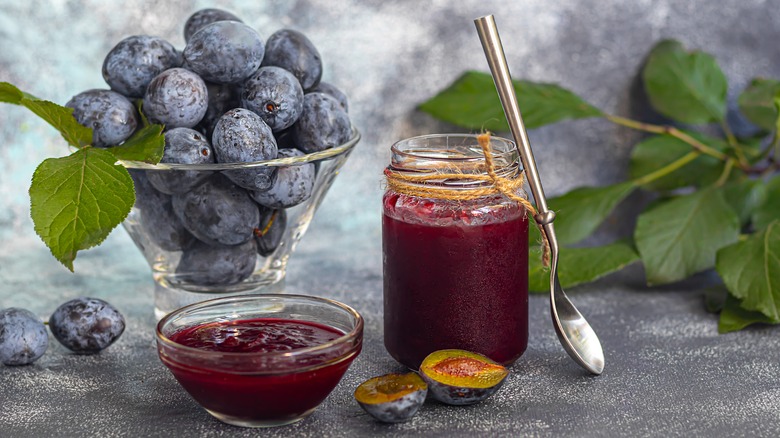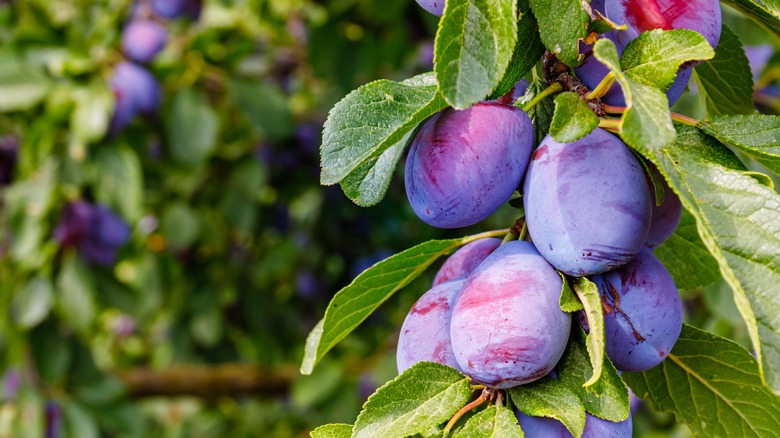The Fruity Ingredient That Makes Up Georgian Tkemali Sauce
Georgian cuisine is an absolute wonderland of astonishing flavor combinations and comfort food staple dishes. Exploring Georgian food will yield almost endless rewards for the home cook. You might already be familiar with bazhe, the versatile nutty and garlicky sauce that goes with just about everything. Now it's time to get to know tkemali sauce, aka "Georgian ketchup." Like ketchup, tkemali is made with fruit (And yes, despite its savory nature, tomatoes are a fruit!) — but unlike ketchup, tkemali features plums and has seasonal variations.
In the spring, unripe wild sour plums (also called tkemali) are used to make the green version of the sauce; the summer gives us the ripe fruit, from which is made sweet red tkemali. Like bazhe, tkemali sauce has many uses and is usually found accompanying grilled meats and potato dishes. Although full of interesting ingredients, tkemali is easy to make and requires no special skill. What you'll get is a marvelous combination of salty, sour, sweet, and herbal flavors with a spicy kick that will perk up any main dish.
How tkemali sauce is made
Unripe tkemali plums are not readily available in the United States (although commercially-prepared green tkemali sauce is), but it's easy enough to make your own variation on sweet red tkemali at home with the ripe version of the fruit we call a cherry plum. Broadly, tkemali sauce is a combination of cooked plums, garlic, fennel, herbs, and ground red pepper. Once you know the basics, you can adjust the ingredients to suit your taste.
First, cook the plums until soft. Peel them and remove the pit, then either grate them or put them in a food processor. Add a healthy amount of chopped herbs — traditionally cilantro, spearmint or pennyroyal, and chives — as well as chopped garlic and fresh fennel root, red chili flakes or hot paprika, and salt. Combine the ingredients in a food processor or with a mortar and pestle. The result is your first batch of tkemali sauce, which can be enjoyed immediately or bottled and stored in the refrigerator.
Tkemali's variations and uses
Although there's an argument to be made that "authentic" tkemali sauce can only be made with the wild Georgian plum, don't be dissuaded. Typically, Georgians make lots of tkemali sauce variations for different uses; you should embrace this spirit of variety when making your own. Love cilantro? Feature it. Not into fennel's anise flavor? Substitute something else. The goal is to give your tkemali a fresh herbal kick, and the variety and amounts of herbs you use to do that are entirely up to you. The same goes for how much spicy heat you're into. It's also not too hard to mimic green tkemali's sourness, either by selecting unripe plums in the grocery store or adding an astringent like lemon juice. All tkemali has a sour quality, but again — the degree to which that's featured is your choice.
In Georgia, tkemali is made to go with fried or grilled meats, but (as with bazhe) Georgians use it constantly, putting it on macaroni, omelets, manifold potato preparations, and steamed vegetables. Based on the amount of love people have for this plummy, herbal concoction — and how simple it is to make — it might be time to go out and look for plums in the produce aisle.


